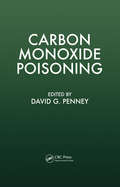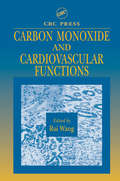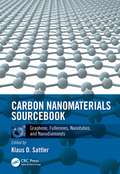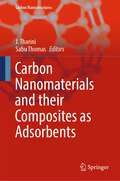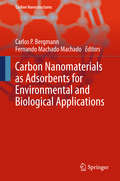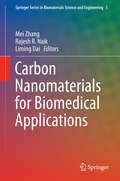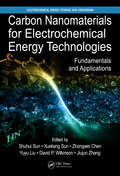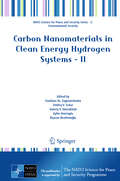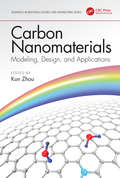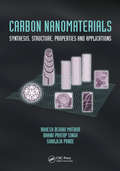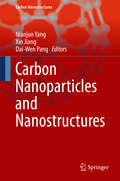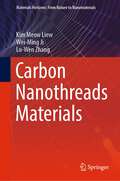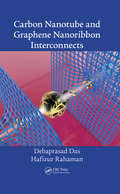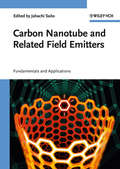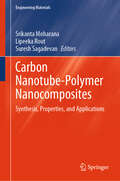- Table View
- List View
Carbon Monoxide Poisoning
by David G. PenneyWhile an ever-present and familiar toxin, carbon monoxide (CO) remains the number one poison in our environment. This silent killer is responsible for over 2,000 deaths a year in the United States alone. The public and healthcare communities need quality information about the many risks presented by carbon monoxide exposure. Edited by a leading e
Carbon Monoxide Toxicity
by Paul C. H. LiPublic interest in the health impacts of carbon monoxide (CO) has been increasing rapidly during the past decade. And rightly so: it is the most ubiquitous environmental poison. Car exhaust fumes, furnaces, gas-powered engines, home water heaters, smoke from all types of fire, and tobacco smoke all contribute to carbon monoxide intoxication - the l
Carbon Monoxide and Cardiovascular Functions
by Rui WangAkin to nitric oxide, carbon monoxide (CO) was initially viewed as a pure toxic gas, yet it has been recently demonstrated to be an important endogenous molecule of gas that has profound physiological and pathophysiological effects on the cardiovascular system. In spite of the growing understanding achieved in this field, until now a comprehensive
Carbon Monoxide in Drug Discovery: Basics, Pharmacology, and Therapeutic Potential (Wiley Series in Drug Discovery and Development)
by Binghe Wang Leo E. OtterbeinCARBON MONOXIDE IN DRUG DISCOVERY An insightful reference for the latest physiological and therapeutic studies of carbon monoxide In Carbon Monoxide in Drug Discovery: Basics, Pharmacology, and Therapeutic Potential, a team of distinguished authors delivers foundational knowledge, the latest research, and remaining challenges regarding the physiological roles and therapeutic efficacy of carbon monoxide (CO). The editors have included a broad selection of resources from leading experts in the field that discuss the background and physiological roles of CO, a variety of delivery forms including CO prodrugs using benign carriers, CO sensing, therapeutic applications, and clinical trials. Organized by topic to allow each chapter to be read individually, the book covers a wide range of topics, from physiological and patho-physiological mechanisms at the molecular level to clinical applications for multiple disease processes. The editors of Carbon Monoxide in Drug Discovery have created a compelling argument for shifting the accepted understanding of CO from poison to bioactive molecule with enormous clinical benefits. Readers will also benefit from: A thorough introduction to the background and physiological actions of carbon monoxide, including endogenous CO production in sickness and in health Comprehensive explorations of CO delivery forms, including non-carrier formulations, metal-carbonyl complexes, and organic CO donors Practical discussions of carbon monoxide sensing and scavenging, including fluorescent probes for intracellular carbon monoxide detection In-depth examinations of the therapeutic applications of CO, including CO in solid organ transplantation Perfect for professors, graduate students, and postdocs in the fields of biology, pharmacology, immunology, medicinal chemistry, toxicology, and drug delivery, Carbon Monoxide in Drug Discovery: Basics, Pharmacology, and Therapeutic Potential is also an invaluable resource for industrial scientists in these areas.
Carbon Nanomaterial Electronics: Devices and Applications (Advances in Sustainability Science and Technology)
by Arnab Hazra Rupam GoswamiThis book brings together selective and specific chapters on nanoscale carbon and applications, thus making it unique due to its thematic content. It provides access to the contemporary developments in carbon nanomaterial research in electronic applications. Written by professionals with thorough expertise in similar broad area, the book is intended to address multiple aspects of carbon research in a single compiled edition. It targets professors, scientists and researchers belonging to the areas of physics, chemistry, engineering, biology and medicine, and working on theory, experiment and applications of carbon nanomaterials.
Carbon Nanomaterials (Advanced Materials and Technologies)
by Yury Gogotsi Volker PresserThis book provides information on synthesis, properties, and applications of carbon nanomaterials. With novel materials, such as graphene (atomically flat carbon) or carbon onions (carbon nanospheres), the family of carbon nanomaterials is rapidly growing. This book provides a state-of-the-art overview and in-depth analysis of the most important ca
Carbon Nanomaterials Based on Graphene Nanosheets
by Ling Bing KongSince the discovery of graphene, it has become one of the most widely and extensively studied materials. This book aims to summarize the progress in synthesis, processing, characterization and applications of a special group of nanocarbon materials derived from graphene or graphene related derivatives by using various strategies in different forms. More specifically, three forms of macrosized materials are presented, i.e., one-dimension or 1D (fibers, wires, yarns, streads, etc.), two-dimension or 2D (films, membranes, papers, sheets, etc.) and three-dimension or 3D (bulk, hydrogels, aerogels, foams, sponges, etc.). Seven chapters are included with the first chapter serving to introduce the concept, definition, and nomenclature of graphene, graphene oxide and their derivatives. The main topics are covered in Chapters 2‒7. Although they have coherent connections, each chapter of them is designed such that they can be studied independently. The target readers of this book include undergraduate students, postgraduate students, researchers, designers, engineers, professors, and program/project managers from the fields of materials science and engineering, applied physics, chemical engineering, biomaterials, materials manufacturing and design, institutes, and research founding agencies.
Carbon Nanomaterials Sourcebook: Graphene, Fullerenes, Nanotubes, and Nanodiamonds, Volume I
by Klaus D. SattlerThe Carbon Nanomaterials Sourcebook contains extensive, interdisciplinary coverage of carbon nanomaterials, encompassing the full scope of the field-from physics, chemistry, and materials science to molecular biology, engineering, and medicine-in two comprehensive volumes.Written in a tutorial style, this first volume of the sourcebook:Focuses on g
Carbon Nanomaterials Sourcebook: Nanoparticles, Nanocapsules, Nanofibers, Nanoporous Structures, and Nanocomposites, Volume II
by Klaus D. SattlerThe Carbon Nanomaterials Sourcebook contains extensive, interdisciplinary coverage of carbon nanomaterials, encompassing the full scope of the field—from physics, chemistry, and materials science to molecular biology, engineering, and medicine—in two comprehensive volumes. Written in a tutorial style, this second volume of the sourcebook: Focuses on nanoparticles, nanocapsules, nanofibers, nanoporous structures, and nanocomposites Describes the fundamental properties, growth mechanisms, and processing of each nanomaterial discussed Explores functionalization for electronic, energy, biomedical, and environmental applications Showcases materials with exceptional properties, synthesis methods, large-scale production techniques, and application prospects Provides the tools necessary for understanding current and future technology developments, including important equations, tables, and graphs Each chapter is dedicated to a different type of carbon nanomaterial and addresses three main areas: formation, properties, and applications. This setup allows for quick and easy search, making the Carbon Nanomaterials Sourcebook: Nanoparticles, Nanocapsules, Nanofibers, Nanoporous Structures, and Nanocomposites a must-have reference for scientists and engineers.
Carbon Nanomaterials and their Composites as Adsorbents (Carbon Nanostructures)
by Sabu Thomas J. ThariniThis book elucidates fundamental concepts of nanomaterials and their pivotal role as nanoadsorbents in water purification. Key features include the latest trends in adsorption for metal, micro pollutants, food adulterants, aromatic compounds, pesticides, dyes, and oil particle removal. Additionally, the interdisciplinary aspects of adsorption and practical applications for hazardous chemical removal from water are explored. The book delves into various types of adsorption isotherms such as Langmuir, Freundlich, BET, and others, offering a deep understanding for water purification. Kinetic models including first, second, and third order kinetics are elucidated, empowering undergraduate students to grasp and optimize complex systems. The required background is basic knowledge in chemistry, biology, mathematics, and nanoscience at the first-year university level. Designed for both academics and industrial researchers, this book is divided into 17 chapters. Chapters 1-7 introduce nanomaterials, carbon nanoadsorbents, their synthesis, and surface modification. Chapters 8-9 cover fundamental adsorption isotherms, kinetic models, thermodynamic parameters, adsorption mechanism, and experimental techniques. Chapters 10-15 delve into the adsorption and desorption of various compounds like aromatic compounds, pesticides, heavy metals, micro pollutants, food adulterants, oil particles, and dyes molecules. The final chapter tackles the theoretical modeling of carbon nanomaterials for adsorption studies
Carbon Nanomaterials as Adsorbents for Environmental and Biological Applications (Carbon Nanostructures)
by Carlos P. Bergmann Fernando Machado MachadoThis book presents a summary of the current use of carbon nanomaterials for water treatment, drug delivery, systems and nanosensors. The first chapter elucidates the adsorption process phenomenon. Also, the properties of different carbon nanomaterials for adsorption applications are covered. The third chapter presents the kinetic and equilibrium models of adsorption, processing of experimental data and adsorption process peculiarities. Environmental and biological applications of carbon nanomaterials are listed in the last chapter. This book is written from an application-oriented perspective and is useful for all those interested in nanoadsorbents.
Carbon Nanomaterials for Biomedical Applications (Springer Series in Biomaterials Science and Engineering #5)
by Liming Dai Mei Zhang Rajesh R. NaikThis book covers a wide range of topics relating to carbon nanomaterials, from synthesis and functionalization to applications in advanced biomedical devices and systems. As they possess unique and attractive chemical, physical, optical, and even magnetic properties for various applications, considerable effort has been made to employ carbon nanomaterials (e. g. , fullerenes, carbon nanotubes, graphene, nanodiamond) as new materials for the development of novel biomedical tools, such as diagnostic sensors, imaging agents, and drug/gene delivery systems for both diagnostics and clinical treatment. Tremendous progress has been made and the scattered literature continues to grow rapidly. With chapters by world-renowned experts providing an overview of the state of the science as well as an understanding of the challenges that lie ahead, Carbon Nanomaterials for Biomedical Applications is essential reading not only for experienced scientists and engineers in biomedical and nanomaterials areas, but also for graduate students and advanced undergraduates in materials science and engineering, chemistry, and biology.
Carbon Nanomaterials for Electrochemical Energy Technologies: Fundamentals and Applications (Electrochemical Energy Storage and Conversion)
by Jiujun Zhang Xueliang Sun Zhongwei Chen David P. Wilkinson Yuyu Liu Shuhui SunThis book offers comprehensive coverage of carbon-based nanomaterials and electrochemical energy conversion and storage technologies such as batteries, fuel cells, supercapacitors, and hydrogen generation and storage, as well as the latest material and new technology development. It addresses a variety of topics such as electrochemical processes, materials, components, assembly and manufacturing, degradation mechanisms, challenges, and strategies. With in-depth discussions ranging from electrochemistry fundamentals to engineering components and applied devices, this all-inclusive reference offers a broad view of various carbon nanomaterials and technologies for electrochemical energy conversion and storage devices.
Carbon Nanomaterials in Clean Energy Hydrogen Systems - II (NATO Science for Peace and Security Series C: Environmental Security)
by Ayfer Veziroğlu Beycan İbrahimoğlu Dmitry V. Schur Svetlana Yu. Zaginaichenko Valeriy V. SkorokhodThis book presents selected contributions to the NATO Advanced Research Workshop "Carbon Nanomaterials in Clean Energy Hydrogen Systems" held in June 2010. These original papers reflect recent progress in response to the modern-day requirements in chemistry of carbon nanomaterials and metal-hydrogen systems. Successor to the 2008 proceedings, this second volume focuses on research and application studies of materials capable of interacting actively with hydrogen, also addressing questions of hydrogen accumulation and storage. As a whole, it provides a review of the most relevant areas of hydrogen materials interactions and carbon nanomaterials science, making it invaluable for all researchers, physicists, chemists, post-graduates and young scientists interested in the structure, properties and applications of different nanocarbon materials.
Carbon Nanomaterials: Modeling Design And Applications (Advances in Materials Science and Engineering)
by Kun ZhouCarbon Nanomaterials: Modeling, Design, and Applications provides an in-depth review and analysis of the most popular carbon nanomaterials, including fullerenes, carbon nanotubes, graphene and novel carbon nanomaterial-based membranes and thin films, with emphasis on their modeling, design and applications. This book provides basic knowledge of the structures, properties and applications of carbon-based nanomaterials. It illustrates the fundamental structure-property relationships of the materials in both experimental and modeling aspects, offers technical guidance in computational simulation of nanomaterials, and delivers an extensive view on current achievements in research and practice, while presenting new possibilities in the design and usage of carbon nanomaterials. This book is aimed at both undergraduate and graduate students, researchers, designers, professors, and professionals within the fields of materials science and engineering, mechanical engineering, applied physics, and chemical engineering.
Carbon Nanomaterials: Synthesis, Structure, Properties and Applications
by Rakesh Behari Mathur Bhanu Pratap Singh Shailaja PandeThe study of nanostructures has become, in recent years, a theme common to many disciplines, in which scientists and engineers manipulate matter at the atomic and molecular level in order to obtain materials and systems with significantly improved properties. Carbon nanomaterials have a unique place in nanoscience owing to their exceptional thermal, electrical, chemical, and mechanical properties, finding application in areas as diverse as super strong composite materials, energy storage and conversion, supercapacitors, smart sensors, targeted drug delivery, paints, and nanoelectronics. This book is the first to cover a broad spectrum of carbon nanomaterials, namely carbon nanofibers, vapor-grown carbon fibers, different forms of amorphous nanocarbons besides carbon nanotubes, fullerenes, graphene, graphene nanoribbons, graphene quantum dots, etc. in a single volume.
Carbon Nanoparticles and Nanostructures (Carbon Nanostructures)
by Nianjun Yang Xin Jiang Dai-Wen PangThis book focuses on carbon dots and diamonds, briefly covering other nanocarbon structures such as nanohorns and nanofibers. In the first part, chemical synthesis of carbon dots, their optical properties and their applications for sensing, catalytic reactions, bio-imaging and drug delivery are presented. The second part of the book deals with the preparation and purification of diamond nanoparticles, their properties and surface chemistry as well as the applications of diamond nanoparticles for seeding, bio-imaging and drug delivery. In the third and last part of the book, other nanostructures such as carbon nanofibers and carbon nanohorns are presented, including their application in electrochemistry, biochemistry and energy.
Carbon Nanostructured Materials: Synthesis, Characterization, and Industrial Applications (SpringerBriefs in Materials)
by Maksym Barabash Alexander Khovavko Eugene Strativnov Andrii Nebesnyi Denis Filonenko Olexiy Sviatenko Angela PiatovaThis book provides a concise yet comprehensive look at carbon nanostructured materials, focusing on synthesis methodologies, applications, and fundamental principles. Based on extensive research conducted at the Gas Institute of the National Academy of Sciences of Ukraine, it offers a thorough examination of recent advancements in the field. The book describes various synthesis techniques, particularly emphasizing the continuous synthesis of carbon nanotubes (CNTs) on metal catalysts using chemical vapor deposition (CVD). It also discusses computational fluid dynamics (CFD) modeling of heating processes associated with carbon materials, crucial for understanding the thermodynamics of complex gas systems relevant to CNTs synthesis. Furthermore, the book discusses the structural properties of carbon nanomaterials, employing techniques such as Raman spectroscopy and optical microscopy. It provides detailed insights into the design and optimization of modern equipment for CNTs synthesis, with a focus on energy-efficient reactors for thermally expanded graphite (TEG) production. Beyond synthesis methodologies, the book explores applications of carbon nanomaterials, including their use in lithium-ion batteries, water purification systems, and nuclear reactors. It offers a serious examination of the potential environmental and technological implications of these materials. Comprising three distinct parts, each supplemented with comprehensive summaries, this book serves as a valuable resource for researchers, engineers, and graduate students in material science, thermal engineering, and nanotechnology. It presents empirical findings, theoretical insights, and practical applications, establishing itself as a valuable addition to the literature in the field of carbon nanostructured materials.
Carbon Nanothreads Materials (Materials Horizons: From Nature to Nanomaterials)
by Kim Meow Liew Wei-Ming Ji Lu-Wen ZhangThis book describes carbon nanothreads with complete and comprehensive knowledge covering theories, numerical methods, and properties comparisons with other carbon-based nanomaterials. For one thing, the main theoretical aspects in this book include: First-Principle Calculation, Density Functional Theory, Classical Molecular Dynamics Simulation, Non-equilibrium Molecular Dynamics Simulation, and Coarse Grained Simulation. For another thing, the main research contents include: Fundamental Mechanical Properties; Fracture Characteristics; Electronic and Magnetic Properties; Thermal Properties; Reinforcement in Polymer Composites; and other promising applications in engineering. The target of this book is to provide to many researchers the available theoretical and numerical methods, and useful computational results of carbon nanothreads for reference. This book can be used as a comprehensive source for scientists, academics, researchers, and engineers in various areas of engineering, physical sciences, and computational modeling. In order to achieve this target, the book introduces the microstructure information of carbon nanothreads and the modeling details at full length. The tunable mechanisms of physical properties of carbon nanothreads are discussed in detail, which enable integration of these nanoscale components into high-order structures for “bottom-up design” purpose. The revealed reinforced mechanisms of carbon nanothreads in polymer composites can provide theoretical guidance for engineering design of advanced polymer composites.
Carbon Nanotube Enhanced Aerospace Composite Materials: A New Generation of Multifunctional Hybrid Structural Composites (Solid Mechanics and Its Applications #188)
by A. Paipetis V. KostopoulosThe well documented increase in the use of high performance composites as structural materials in aerospace components is continuously raising the demands in terms of dynamic performance, structural integrity, reliable life monitoring systems and adaptive actuating abilities. Current technologies address the above issues separately; material property tailoring and custom design practices aim to the enhancement of dynamic and damage tolerance characteristics, whereas life monitoring and actuation is performed with embedded sensors that may be detrimental to the structural integrity of the component. This publication explores the unique properties of carbon nanotubes (CNT) as an additive in the matrix of Fibre Reinforced Plastics (FRP), for producing structural composites with improved mechanical performance as well as sensing/actuating capabilities. The successful combination of the CNT properties and existing sensing actuating technologies leads to the realization of a multifunctional FRP structure. The current volume presents the state of the art research in this field. The contributions cover all the aspects of the novel composite systems, i.e. modeling from nano to macro scale, enhancement of structural efficiency, dispersion and manufacturing, integral health monitoring abilities, Raman monitoring, as well as the capabilities that ordered carbon nanotube arrays offer in terms of sensing and/or actuating in aerospace composites.
Carbon Nanotube and Graphene Nanoribbon Interconnects
by Hafizur Rahaman Debaprasad DasAn Alternative to Copper-Based Interconnect Technology With an increase in demand for more circuit components on a single chip, there is a growing need for nanoelectronic devices and their interconnects (a physical connecting medium made of thin metal films between several electrical nodes in a semiconducting chip that transmit signals from one point to another without any distortion). Carbon Nanotube and Graphene Nanoribbon Interconnects explores two new important carbon nanomaterials, carbon nanotube (CNT) and graphene nanoribbon (GNR), and compares them with that of copper-based interconnects. These nanomaterials show almost 1,000 times more current-carrying capacity and significantly higher mean free path than copper. Due to their remarkable properties, CNT and GNR could soon replace traditional copper interconnects. Dedicated to proving their benefits, this book covers the basic theory of CNT and GNR, and provides a comprehensive analysis of the CNT- and GNR-based VLSI interconnects at nanometric dimensions. Explore the Potential Applications of CNT and Graphene for VLSI Circuits The book starts off with a brief introduction of carbon nanomaterials, discusses the latest research, and details the modeling and analysis of CNT and GNR interconnects. It also describes the electrical, thermal, and mechanical properties, and structural behavior of these materials. In addition, it chronicles the progression of these fundamental properties, explores possible engineering applications and growth technologies, and considers applications for CNT and GNR apart from their use in VLSI circuits. Comprising eight chapters this text: Covers the basics of carbon nanotube and graphene nanoribbon Discusses the growth and characterization of carbon nanotube and graphene nanoribbon Presents the modeling of CNT and GNR as future VLSI interconnects Examines the applicability of CNT and GNR in terms of several analysis works Addresses the timing and frequency response of the CNT and GNR interconnects Explores the signal integrity analysis for CNT and GNR interconnects Models and analyzes the applicability of CNT and GNR as power interconnects Considers the future scope of CNT and GNR Beneficial to VLSI designers working in this area, Carbon Nanotube and Graphene Nanoribbon Interconnects provides a complete understanding of carbon-based materials and interconnect technology, and equips the reader with sufficient knowledge about the future scope of research and development for this emerging topic.
Carbon Nanotube and Related Field Emitters: Fundamentals and Applications
by Yahachi SaitoCarbon nanotubes (CNTs) have novel properties that make them potentially useful in many applications in nanotechnology, electronics, optics and other fields of materials science. These characteristics include extraordinary strength, unique electrical properties, and the fact that they are efficient heat conductors. Field emission is the emission of electrons from the surface of a condensed phase into another phase due to the presence of high electric fields. CNT field emitters are expected to make a breakthrough in the development of field emission display technology and enable miniature X-ray sources that will find a wide variety of applications in electronic devices, industry, and medical and security examinations. This first monograph on the topic covers all aspects in a concise yet comprehensive manner - from the fundamentals to applications. Divided into four sections, the first part discusses the preparation and characterization of carbon nanotubes, while part two is devoted to the field emission properties of carbon nanotubes, including the electron emission mechanism, characteristics of CNT electron sources, and dynamic behavior of CNTs during operation. Part three highlights field emission from other nanomaterials, such as carbon nanowalls, diamond, and silicon and zinc oxide nanowires, before concluding with frontier R&D applications of CNT emitters, from vacuum electronic devices such as field emission displays, to electron sources in electron microscopes, X-ray sources, and microwave amplifiers. Edited by a pioneer in the field, each chapter is written by recognized experts in the respective fields.
Carbon Nanotube-Based Sensors: Fabrication, Characterization, and Implementation
by Anindya Nag Alivia MukherjeeCarbon Nanotube-Based Sensors: Fabrication, Characterization, and Implementation highlights the latest research and developments on carbon nanotubes (CNTs) and their applications in sensors and sensing systems. It offers an overview of CNTs, including their synthesis, functionalization, characterization, and toxicology. It then delves into the fabrication and various applications of CNT-based sensors.FEATURES Defines the significance of different forms of CNT-based sensors synthesized for diverse engineering applications and compares the feasibility of their generation Helps readers evaluate different types of fabrication techniques to generate CNTs and their subsequent sensing Discusses fabrication of low-cost, efficient CNTs-based sensors that can be used for diverse applications and sheds light on synthesis methods for a range of printing techniques Highlights challenges and advances in security-related issues using CNTs-based sensors This book is aimed at researchers in the fields of materials and electrical engineering who are interested in the development of sensor technology for industrial, biomedical, and related applications.
Carbon Nanotube-Polymer Composites: Manufacture, Properties, and Applications
by Brian P. GradyThe accessible compendium of polymers in carbon nanotubes (CNTs) Carbon nanotubes (CNTs)—extremely thin tubes only a few nanometers in diameter but able to attain lengths thousands of times greater—are prime candidates for use in the development of polymer composite materials. Bringing together thousands of disparate research works, Carbon Nanotube-Polymer Composites: Manufacture, Properties, and Applications covers CNT-polymers from synthesis to potential applications, presenting the basic science and engineering of this dynamic and complex area in an accessible, readable way. Designed to be of use to polymer scientists, engineers, chemists, physicists, and materials scientists, the book covers carbon nanotube fundamentals to help polymer experts understand CNTs, and polymer physics to help those in the CNT field, making it an invaluable resource for anyone working with CNT-polymer composites. Detailed chapters describe the mechanical, rheological, electrical, and thermal properties of carbon nanotube-polymer composites. Including a glossary that defines key terms, Carbon Nanotube-Polymer Composites is essential reading for anyone looking to gain a fundamental understanding of CNTs and polymers, as well as potential and current applications, including electronics (shielding and transparent electrodes), flame retardants, and electromechanics (sensors and actuators), and their challenges.
Carbon Nanotube-Polymer Nanocomposites: Synthesis, Properties, and Applications (Engineering Materials)
by Suresh Sagadevan Srikanta Moharana Lipeeka RoutThis book presents the latest advancements in various synthetic techniques, properties, characterization, and efficient applications of CNT-polymer nanocomposites. The preparation, properties, characterization, and applications of these technologically intriguing new materials are discussed in detail. The book covers a wide range of topics from the fundamentals of carbon nanotubes, their reinforced polymer nanocomposites and their applications in various fields including energy storage, 3D printing, electronics, aerospace and coatings, and environmental and bio-medical/bioengineering. It is a good resource for students, material scientists, and professionals interested in the synthesis, properties, characteristics, and cutting-edge applications of carbon nanotubes-polymer nanocomposites.
